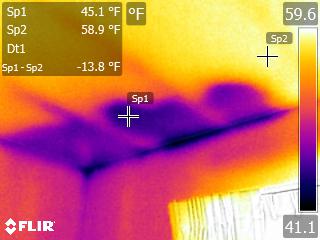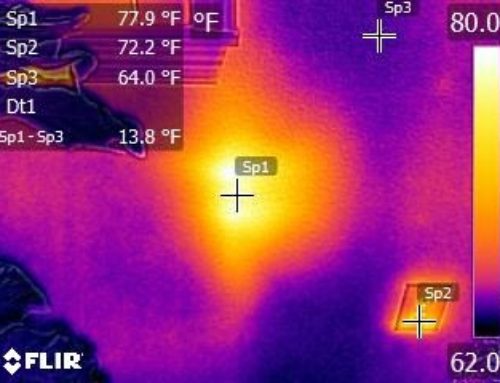By Doug Fast
The last blog was an introduction to infrared thermography and some basic facts about how thermal imaging works. This blog is going to touch on what the benefits are of conducting thermal imaging as part of the home inspection process, and why it will someday be considered standard practice.
There are numerous advantages to use an infrared camera at inspection, but we are going to focus on the top for reasons:
1. Finding potential air movement concerns from the interior to the exterior of the house – This can show issues with insulation, caulking, or weather-stripping, as well as solid materials that can have poor insulation values (solid masonry).
2. Moisture Intrusion – Whether this is on the exterior of the home looking at stucco penetration, or on the interior of the home for drywall penetration, the Infrared camera is able to pick up active moisture leaks. Anytime there is a possible moisture concern, we always use a moisture meter to verify that what we are seeing with the IR camera is in fact moisture. In many cases, what looks like possible moisture ends up being poor insulation in this area.
3. Electrical issues not visible with the human eye – The
An infrared camera can indicate switches or outlets that are excessively hot, breakers or wiring within the electrical panel that are excessively hot, or even wiring within the wall that is giving off excessive heat. All these things would not be visible with the eye, and can be electrical concerns that the IR camera can help identify. It does not matter the age of the house to have electrical concerns, but certainly, older homes can have more issues.
4. Heating/Cooling concerns – The infrared camera is able to identify when there are duct leaks. Sometimes this can be very visible when we have a direct line of sight to the ducting, as in the basement or crawl space. Other times, we can find hot/cold spots on the walls that can indicate duct issues, but without destructive testing, these can be difficult to verify.
This is just a small snapshot of the advantages of using an infrared camera during the home inspection, but hopefully, gives some big reasons to consider adding this to your next inspection. The final blog in the 3-part series will focus on limitations to infrared thermography.


